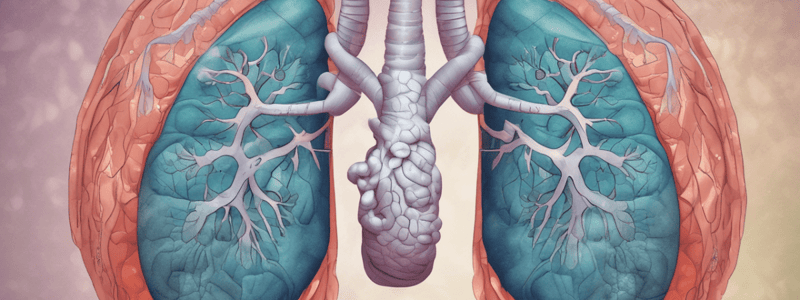Podcast
Questions and Answers
What is the primary symptom of acute respiratory distress syndrome (ARDS)?
What is the primary symptom of acute respiratory distress syndrome (ARDS)?
- Tachycardia
- Hypertension
- Fever
- Dyspnea (correct)
Which of the following is a common cause of chronic obstructive pulmonary disease (COPD)?
Which of the following is a common cause of chronic obstructive pulmonary disease (COPD)?
- Sepsis
- Pneumonia
- Trauma
- Tobacco smoke (correct)
What is the primary mechanism of action of bronchodilators in the treatment of COPD?
What is the primary mechanism of action of bronchodilators in the treatment of COPD?
- Relaxation of airway smooth muscle (correct)
- Inhibition of muscarinic receptors
- Stimulation of beta-adrenergic receptors
- Inhibition of phosphodiesterase
Which of the following medications is used to treat pulmonary embolism (PE)?
Which of the following medications is used to treat pulmonary embolism (PE)?
What is a common side effect of corticosteroids in the treatment of respiratory disorders?
What is a common side effect of corticosteroids in the treatment of respiratory disorders?
Why is it important to adjust medication dosages in patients with renal or hepatic impairment?
Why is it important to adjust medication dosages in patients with renal or hepatic impairment?
What is a critical consideration when using bronchodilators, corticosteroids, and thrombolytics in combination?
What is a critical consideration when using bronchodilators, corticosteroids, and thrombolytics in combination?
What is the primary indication for the use of corticosteroids in respiratory disorders?
What is the primary indication for the use of corticosteroids in respiratory disorders?
Flashcards
What is Acute Respiratory Distress Syndrome (ARDS)?
What is Acute Respiratory Distress Syndrome (ARDS)?
A condition where the tiny air sacs (alveoli) in the lungs become inflamed and leaky, leading to difficulty breathing.
What is Chronic Obstructive Pulmonary Disease (COPD)?
What is Chronic Obstructive Pulmonary Disease (COPD)?
A progressive lung disease that makes it tough to breathe out air, caused by inflammation and damage to the airways and lung tissue.
What is a Pulmonary Embolism (PE)?
What is a Pulmonary Embolism (PE)?
A blood clot that travels to the lungs and blocks an artery, preventing blood flow to that part of the lung.
What are Bronchodilators?
What are Bronchodilators?
Signup and view all the flashcards
What are Corticosteroids?
What are Corticosteroids?
Signup and view all the flashcards
What are Thrombolytics?
What are Thrombolytics?
Signup and view all the flashcards
What is medication dosing adjustment in renal or hepatic impairment?
What is medication dosing adjustment in renal or hepatic impairment?
Signup and view all the flashcards
What are medication interactions?
What are medication interactions?
Signup and view all the flashcards
Study Notes
Pulmonary Disorders
Acute Respiratory Distress Syndrome (ARDS)
- Definition: acute inflammatory lung injury leading to impaired gas exchange
- Causes: sepsis, pneumonia, aspiration, trauma, pancreatitis
- Symptoms: dyspnea, tachypnea, hypoxemia, bilateral infiltrates on chest radiograph
- Treatment: mechanical ventilation, oxygen therapy, prone positioning, neuromuscular blockade, corticosteroids
Chronic Obstructive Pulmonary Disease (COPD)
- Definition: progressive lung disease characterized by airflow limitation
- Causes: tobacco smoke, air pollution, genetic factors
- Symptoms: dyspnea, cough, wheezing, chronic bronchitis, emphysema
- Treatment: bronchodilators, corticosteroids, phosphodiesterase-4 inhibitors, oxygen therapy, pulmonary rehabilitation
Pulmonary Embolism (PE)
- Definition: obstruction of pulmonary arteries by thrombi
- Causes: deep vein thrombosis, immobility, cancer, trauma
- Symptoms: dyspnea, chest pain, tachypnea, hypoxemia
- Treatment: anticoagulation, thrombolysis, inferior vena cava filters, embolectomy
Pharmacological Management
Bronchodilators
- β2-agonists (e.g., albuterol, salmeterol): relax airway smooth muscle, increase bronchodilation
- Anticholinergics (e.g., tiotropium, ipratropium): inhibit muscarinic receptors, reduce bronchial secretions
- Methylxanthines (e.g., theophylline): inhibit phosphodiesterase, increase cAMP, relax airway smooth muscle
Corticosteroids
- Mechanism: reduce inflammation, suppress immune response
- Indications: asthma, COPD, ARDS, pneumonia
- Side effects: hyperglycemia, hypertension, osteoporosis, adrenal suppression
Thrombolytics
- Mechanism: dissolve thrombi, restore blood flow
- Indications: pulmonary embolism, deep vein thrombosis
- Side effects: bleeding, allergic reactions, thrombocytopenia
Critical Care Pharmacy Considerations
Medication Dosing in Renal or Hepatic Impairment
- Adjust dosages based on renal or hepatic function to avoid toxicity
Medication Interactions
- Monitor for interactions between bronchodilators, corticosteroids, and thrombolytics
- Adjust dosages or alternative medications as needed
Pulmonary Disorders
Acute Respiratory Distress Syndrome (ARDS)
- Acute inflammatory lung injury leading to impaired gas exchange
- Caused by sepsis, pneumonia, aspiration, trauma, or pancreatitis
- Symptoms include dyspnea, tachypnea, hypoxemia, and bilateral infiltrates on chest radiograph
- Treated with mechanical ventilation, oxygen therapy, prone positioning, neuromuscular blockade, and corticosteroids
Chronic Obstructive Pulmonary Disease (COPD)
- Progressive lung disease characterized by airflow limitation
- Caused by tobacco smoke, air pollution, or genetic factors
- Symptoms include dyspnea, cough, wheezing, chronic bronchitis, and emphysema
- Treated with bronchodilators, corticosteroids, phosphodiesterase-4 inhibitors, oxygen therapy, and pulmonary rehabilitation
Pulmonary Embolism (PE)
- Obstruction of pulmonary arteries by thrombi
- Caused by deep vein thrombosis, immobility, cancer, or trauma
- Symptoms include dyspnea, chest pain, tachypnea, and hypoxemia
- Treated with anticoagulation, thrombolysis, inferior vena cava filters, or embolectomy
Pharmacological Management
Bronchodilators
- β2-agonists (e.g., albuterol, salmeterol) relax airway smooth muscle and increase bronchodilation
- Anticholinergics (e.g., tiotropium, ipratropium) inhibit muscarinic receptors and reduce bronchial secretions
- Methylxanthines (e.g., theophylline) inhibit phosphodiesterase, increase cAMP, and relax airway smooth muscle
Corticosteroids
- Reduce inflammation and suppress immune response
- Indicated for asthma, COPD, ARDS, and pneumonia
- Side effects include hyperglycemia, hypertension, osteoporosis, and adrenal suppression
Thrombolytics
- Dissolve thrombi and restore blood flow
- Indicated for pulmonary embolism and deep vein thrombosis
- Side effects include bleeding, allergic reactions, and thrombocytopenia
Critical Care Pharmacy Considerations
Medication Dosing in Renal or Hepatic Impairment
- Adjust dosages based on renal or hepatic function to avoid toxicity
Medication Interactions
- Monitor for interactions between bronchodilators, corticosteroids, and thrombolytics
- Adjust dosages or alternative medications as needed
Studying That Suits You
Use AI to generate personalized quizzes and flashcards to suit your learning preferences.





